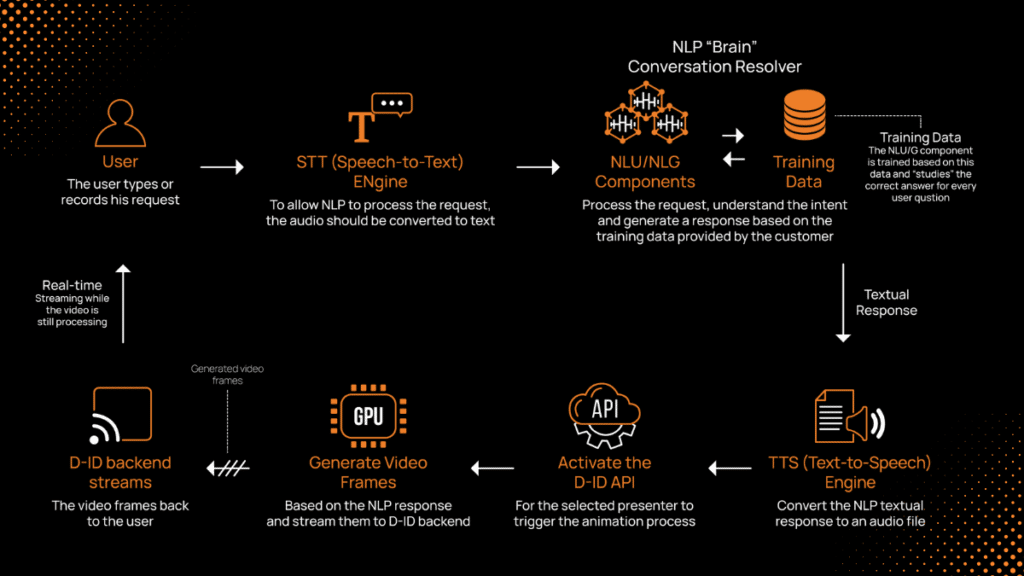Navigating the AI Avatar Landscape: A 2026 Guide for Enterprise Leaders

Let’s face it, exploring the world of enterprise AI avatar platforms can be overwhelming. From flashy demos to technical jargon, it’s hard to know which solution will actually work at scale for your business. In cases your customers expect intelligent, personalized service 24/7, you don’t just need a talking head video creation platform, you need an advanced solution enabling your avatar to listen, respond, and speak in real-time for the full digital human experience.
This guide is here to help you cut through the noise by giving you a clear picture of the landscape and your options. While many tools offer some form of AI-driven avatar or video generation, only a select few deliver truly interactive, real-time experiences suitable for enterprise customer engagement. These are the platforms worth taking a closer look at. We’ll break down the different types of avatar tools on the market, compare some of the top players, and show you what to look for if you’re serious about transforming customer experience at an enterprise level.
Key Terms
Avatar
An avatar is a lifelike digital persona, usually a human face or full-body figure, that is animated by AI to speak, emote, and convey information on screen. Modern platforms let enterprises spin up thousands of such avatars for marketing, training, or customer support content at scale.
AI Agent
An autonomous software entity that senses its environment, reasons with machine-learning models or symbolic rules, and takes actions toward a goal. In practice, an AI Agent might schedule meetings, optimize supply chains, or troubleshoot network issues, all without human micromanagement.
Visual Agent
A step beyond a plain avatar. A Visual Agent is an avatar combined with a connected AI Agent capable of real-time video engagement. This allows the character to listen, think, and respond naturally in live two-way conversations. Think of it as a customer‐service rep who lives inside your app or kiosk.
LLM (Large Language Model)
A generative AI model trained on vast text corpora. When you plug an LLM into your system, it supplies the conversational intelligence that drives an AI Agent or Visual Agent; enabling nuanced, context-aware dialog.
API (Application Programming Interface)
The set of endpoints your software calls to create, control, and stream avatars. D-ID’s real-time streaming API, for example, delivers up to 100 FPS video and hooks into any LLM or NLU engine, making it the connective tissue between your logic and the Visual Agent on screen.
Mapping the AI Avatar Landscape
There’s no one-size-fits-all solution. Most AI avatar tools fall into one of four categories:
All-in-One Avatar Creation Platforms These are designed for simplicity and speed. You input a script, choose an avatar, and generate a video. Great for marketing teams, internal communications, and L&D content.
- Example Platforms: D-ID, Synthesia, HeyGen, DeepBrain
Text-to-Video Generators These models generate cinematic, stylized clips from text, images, or motion input. They’re powerful for storytelling, creative exploration, and concept development, but not yet suitable for reliable speech or lip-sync accuracy in enterprise settings.
- Example Platforms: Runway, Pika, Sora
API & SDK-Driven Platforms Ideal for developers and product teams. These platforms provide real-time avatar capabilities and deep integration hooks for apps, kiosks, or web tools.
- Example Platforms: D-ID API, Soul Machines, Heygen, Inworld AI
Conversational AI Avatars This emerging category is designed for intelligent, back-and-forth communication. These avatars can carry on real-time conversations by connecting to a large language model or AI agent like ChatGPT, Copilot, or your own assistant. The result: digital humans that feel helpful, responsive, and alive.
- Example Platforms: D-ID, Tavus, Soul Machines

Key Players in Interactive Avatar Solutions
This section focuses specifically on platforms that support interactive, real-time avatars—tools that go beyond video generation and actually enable back-and-forth engagement with customers. These players are building visual agents designed to integrate with LLMs, respond to user input, and hold meaningful, conversational experiences.
Use cases for these platforms vary, but typically include: AI-powered customer service agents, virtual financial advisors, onboarding assistants, personalized sales concierges, healthcare navigators, and interactive training facilitators. Each one requires the ability to listen, respond, and adapt in on the spot—traits that separate interactive avatars from static video solutions.
Several players have emerged in the AI avatar space, but not all are built with enterprise needs in mind.

D-ID
Is a global leader in generative AI video and interactive avatar technology, empowering organizations to create human-like digital experiences at scale. The company’s platform spans from self-service video creation to real-time conversational avatars, enabling seamless integration with large language models and enterprise systems. Trusted by Fortune 100 companies, D-ID’s technology is used across marketing, customer service, learning, and internal communications to make digital interactions more personal, engaging, and accessible. With a developer-friendly API and Creative Reality™ Studio, D-ID bridges the gap between video and conversation—bringing the face of AI to life.
HeyGen
Provides a streamlined interface for video-based avatars and localization. Security-wise, HeyGen is SOC 2 and GDPR compliant and makes clear that customer data is not used to train its models. However, further details on fine-grained enterprise controls, access management, or audit tooling are limited in public-facing documentation. It’s mostly used for content generation, with limited real-time capabilities and less focus on interactive experiences. While it offers an API and basic integrations, the platform is better suited for one-way video outputs rather than live CX engagement.
Tavus
Focuses on delivering AI-powered digital avatars for live interactions. While Tavus emphasizes a security-first design and offers enterprise-grade SLAs, it does not currently list formal compliance certifications such as SOC 2 or ISO 27001. Enterprises should request documentation on their security practices during evaluation. With an emphasis on dynamic communication rather than static video, Tavus enables companies to deploy personalized, on-brand virtual agents across channels. Their API and developer-first mindset make it relatively straightforward to embed these avatars into custom workflows. That said, the platform is still evolving in terms of breadth and enterprise-ready tooling, and may require additional customization for complex deployments or high-scale scenarios.
Soul Machines
Offers a visually elaborate solution, building 3D animated avatars with reactive facial expressions. Soul Machines is GDPR-aligned and partners with secure cloud infrastructure providers, such as AWS and Azure. However, it does not publicly list certifications like SOC 2 or ISO standards, and enterprises should vet compliance details directly. The implementation is complex, the infrastructure demands are significant, and the costs often outweigh the value for typical enterprise deployments. For most organizations, the barrier to entry is too high, and integration into existing CX systems is cumbersome.
UNITH
Offers digital humans that support conversational AI, primarily through its interFace platform. UNITH claims to offer enterprise-ready APIs and deployment controls, but does not currently publish detailed security documentation or third-party certifications. For regulated industries, direct assessment of their privacy and data handling policies is recommended. These avatars can be embedded into websites, apps, and services to guide users, answer questions, or serve as interactive brand representatives. UNITH promotes a no-code interface and API access, which makes it accessible for non-technical teams while still offering integration capabilities. While flexible, it remains to be seen how the platform handles highly complex enterprise requirements in areas like real-time responsiveness, deep customization, or global scalability.
Why D-ID is the Enterprise Choice
D-ID offers the right blend of usability, flexibility, and enterprise performance. Our platform was purpose-built for global organizations that need to deliver consistent, human-like interactions at scale, without compromising on security or speed.

1. Built for Integration
At D-ID, everything starts with the API. Whether you’re building avatar-powered customer agents, embedding visual assistants into websites or mobile apps, or integrating with internal systems, our platform is engineered to fit your stack. You can connect D-ID to your existing NLU engine, CRM, or contact center with minimal lift.
We also support non-technical teams with integrations into tools like PowerPoint, Canva, and LMS platforms. Teams can create avatar-led content in minutes, without needing to code.2. Enterprise-Grade Security & Privacy
2. Enterprise-Grade Security & Privacy
Security isn’t an afterthought. It’s the foundation. D-ID is SOC 2 certified and complies with GDPR, as well as multiple ISO standards (27001, 27017, 27018, 27701). We implement content moderation, watermarking, and strict access controls to prevent misuse.
Unlike some vendors, we never use your data to train our models. Whether you’re in finance, healthcare, or any compliance-heavy sector, you can rely on D-ID to meet and exceed your internal security requirements.
3. Real-Time Interaction, Delivered
We go beyond video generation. D-ID’s real-time streaming avatars let your AI interact with users through natural, responsive video. Connect any LLM or dialog system to our streaming API, and deploy lifelike avatars that respond in real-time.
This opens the door for 24/7 visual agents that feel intuitive and engaging, available in over 120 languages, with expressive facial movement, high-quality voice output, and lightning-fast response time.
4. Proven Scale and Reliability
Over half of the Fortune 100 already use D-ID. Whether you’re rolling out internal training, external support visual agents, or marketing videos across multiple regions, our infrastructure is built to support it. We deliver videos at up to 100 frames per second and process millions of requests each month.
From a pilot to a full global roll out, D-ID is ready to grow with you.
5. Support That Doesn’t Sleep
We provide 24/7 support to all API and Studio customers. Our team includes technical support engineers, onboarding specialists, and dedicated account managers for enterprise clients. We’re with you before, during, and after implementation, helping you optimize, troubleshoot, and scale.
Final Thoughts
There are a lot of great tools out there. If you’re experimenting or creating niche experiences, mixing and matching them can work. But if you’re leading a team at scale, managing compliance, and accountable for results, the stakes are higher.
D-ID was built for you. We combine a powerful, mature API with real-time capabilities, world-class compliance, and dedicated support. Whether you need to launch quickly or build a deeply customized avatar solution tied to your own AI stack, D-ID is the partner to help you get there.
If you’re ready to elevate your brand by implementing avatar videos or interactive avatars, choose D-ID.
Was this post useful?
Thank you for your feedback!
 Ron Friedman
Ron Friedman